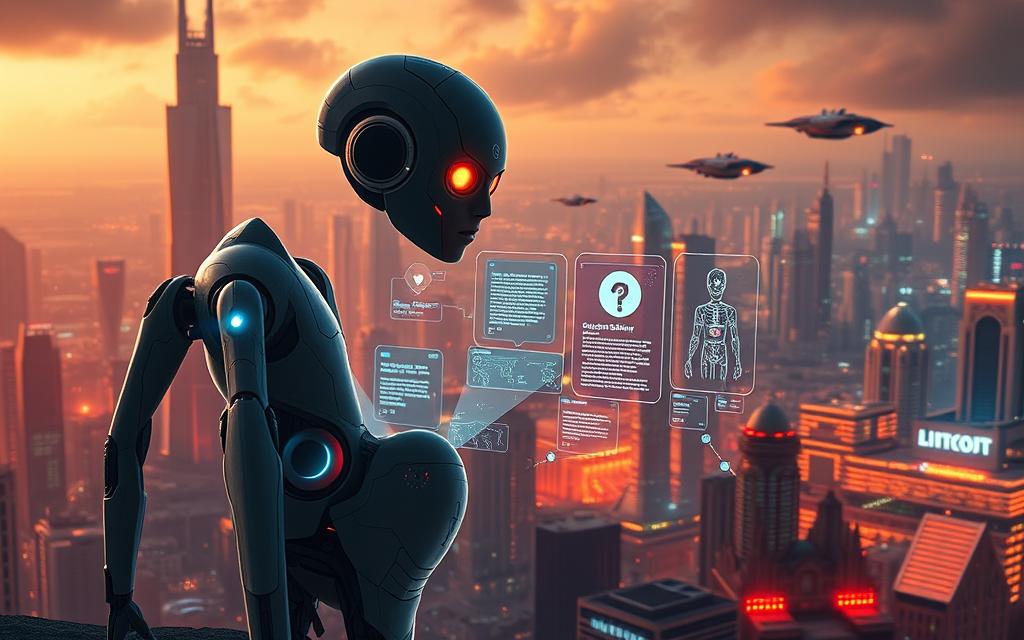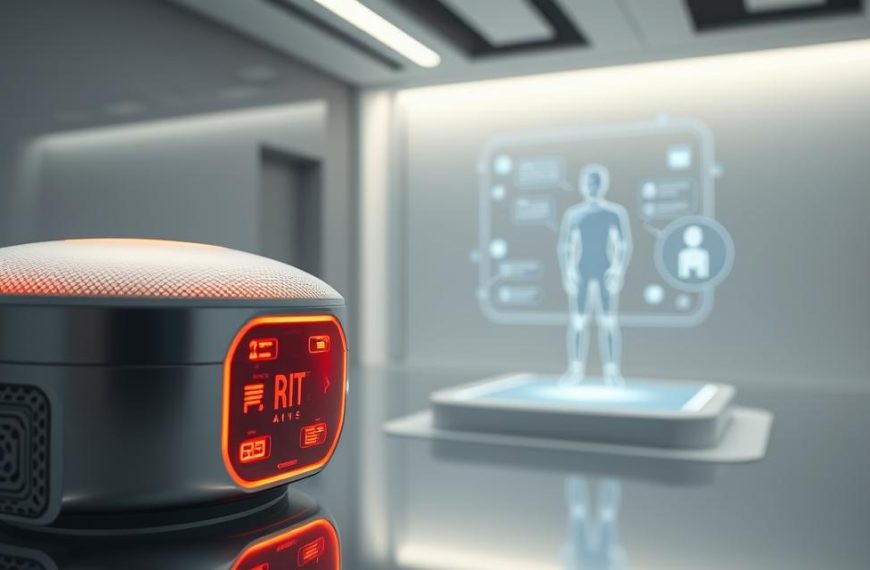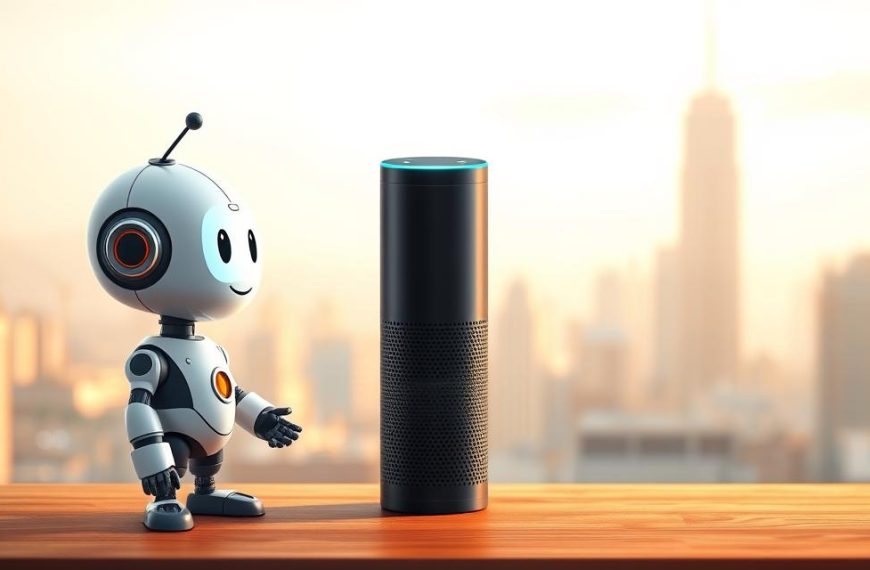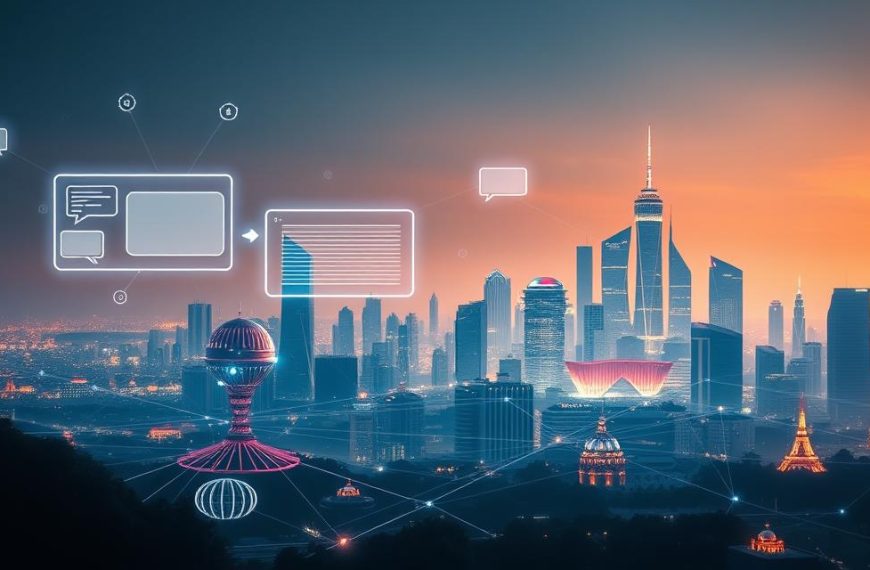Modern advancements in language processing have revolutionised how people interact with computers. At first glance, systems like OpenAI’s ChatGPT appear groundbreaking. Yet the idea of machines mimicking human conversation stretches back decades.
This exploration examines whether contemporary chatbots represent entirely new concepts or evolved iterations of earlier innovations. While tools like ChatGPT-4 showcase remarkable fluency, their foundations lie in research dating to the mid-20th century. Early programmes such as ELIZA demonstrated basic dialogue capabilities as far back as 1966.
The distinction between rule-based systems and machine learning models proves critical. Initial chatbots relied on predefined scripts, whereas modern counterparts utilise vast data sets and neural networks. This shift enables more natural exchanges, but doesn’t erase historical contributions.
Understanding this progression helps contextualise today’s technology. From simple pattern-matching to adaptive learning, each development built upon prior breakthroughs. Subsequent sections will trace key milestones that shaped conversational AI into its current form.
Introduction to AI Chatbots and Their Evolution
Digital communication has undergone transformative changes through automated dialogue systems. While these tools surged in popularity during the 2010s, their roots trace back to mid-20th-century experiments with pattern recognition.
Overview of Chatbot Development
Early systems relied on rigid decision trees, matching keywords to prewritten replies. Modern iterations employ neural networks trained on vast datasets, enabling nuanced exchanges. Three key advancements fuelled this shift:
- Improved processing power for real-time analysis
- Natural language understanding breakthroughs
- Messaging platform integration
These developments allow contemporary models to handle complex queries across sectors. Banking institutions now resolve 80% of routine customer conversations through automated interfaces.
The Impact on Digital Communication
Always-available assistants have redefined service expectations. Users demand instant resolutions whether ordering groceries or troubleshooting devices. This immediacy comes with trade-offs:
Some organisations exploit the technology for manipulative marketing or biased search results. Nevertheless, ethical implementations demonstrate value – healthcare chatbots triage 30% of non-emergency NHS enquiries daily.
As adoption grows, balancing innovation with accountability remains critical. The next sections explore how foundational research shaped today’s sophisticated systems.
The Birth of Chatbots: Joseph Weizenbaum and ELIZA
Long before modern chatbots, a 1960s computer programme surprised its creator with unexpected emotional responses. At MIT, Joseph Weizenbaum developed ELIZA – a text-based system that mimicked psychotherapy sessions. This first chatbot used scripted rules to rephrase user inputs as questions, creating an illusion of understanding.
The Creation of ELIZA as a Pioneering Technology
Weizenbaum’s programme operated through pattern matching rather than true comprehension. When users shared personal struggles, ELIZA responded with prompts like “Why do you feel that way?”. Its design intentionally exposed the shallow nature of machine conversation, yet people formed genuine attachments. Secretaries at MIT reportedly requested privacy while “confiding” in the software.
| Feature | ELIZA (1966) | Modern Chatbots |
|---|---|---|
| Response Generation | Keyword-based scripts | Neural network predictions |
| Learning Method | Static rules | Continuous data training |
| User Perception | Attributed empathy | Expected contextual awareness |
Weizenbaum’s Perspective on Machine Intelligence
The computer scientist grew alarmed by how readily humans anthropomorphised his creation. He observed: “What I had not realised is that extremely short exposures to a relatively simple computer programme could induce powerful delusional thinking.” This phenomenon, later termed the ELIZA effect, revealed more about human psychology than technical achievement.
Weizenbaum became a vocal critic of making computers substitutes for human judgement. In his later writings, he argued machines lack the moral reasoning essential for complex social interactions. His warnings about ethical implications of machine dependency remain relevant as AI grows more persuasive.
The Rise of Conversational Interfaces in the Digital Age
Messaging platforms became unexpected laboratories for conversational experiments in the 2000s. Programmes like Jabberwacky (1988) shifted chatbots from clinical simulations to entertainment, using humour and pop culture references. This era saw machines evolve from rigid question-answer scripts to tools handling weather updates, jokes, and even stock quotes.
Advancements Through Social Media and Messaging Apps
The 2001 launch of SmarterChild on AOL Instant Messenger marked a turning point. It answered trivia, converted currencies, and engaged 5 million daily users – planting the idea of AI assistants in public consciousness. By 2009, WeChat’s ecosystem in China demonstrated chatbots could book flights or pay bills through natural language commands.
| Era | Technology | User Interaction |
|---|---|---|
| 1970s-2000s | Scripted responses (PARRY, A.L.I.C.E.) | Single-purpose queries |
| 2010s-present | AI-driven contextual analysis | Multi-step transactions |
Integration in Daily Digital Interactions
Voice-operated systems like Dr. Sbaitso (1992) paved the way for hands-free assistance. When Facebook opened its Messenger API in 2016, brands deployed chatbots handling 53% of customer conversations without human intervention. Users now expect seamless transitions between text, voice, and visual inputs across devices – a standard set by these early innovators.
From ordering pizza via Slack to checking bank balances through WhatsApp, conversational interfaces have become invisible yet essential tools. As Rollo Carpenter, creator of Jabberwacky, noted: “The true test isn’t whether machines think, but whether they help people think less about mundane things.”
Was ChatGPT the first AI chatbot?
Conversational interfaces have evolved through iterative breakthroughs rather than sudden inventions. The latest tools represent decades of refinements in machine language processing and user interaction design.
The Emergence of ChatGPT in the AI Landscape
Modern systems like ChatGPT and Google Gemini utilise transformer architectures trained on billions of text samples. This enables fluid conversations spanning technical queries and creative tasks. Unlike script-driven predecessors, these models adapt responses based on contextual clues within dialogues.
Three factors distinguish current chatbots from earlier programmes:
- Real-time learning from global user interactions
- Integration with cloud-based information repositories
- Multimodal input handling (text, voice, images)
Comparative Historical Insights
Early systems achieved limited success through rigid decision trees. The table below illustrates how core technologies have progressed:
| Aspect | ELIZA (1966) | 2010s Chatbots | ChatGPT |
|---|---|---|---|
| Architecture | Pattern-matching scripts | Machine learning algorithms | Neural networks |
| Training Data | 200 lines of code | 10,000 dialogue examples | 570GB text corpus |
| Context Handling | Single exchange | 3-5 message memory | 3,000+ token memory |
This progression shows how each generation addressed prior limitations. While ELIZA mimicked human conversation superficially, today’s tools resolve complex requests through probabilistic reasoning. The field now focuses on reducing factual errors – a challenge inherited from earlier systems’ struggle with accuracy.
Comparing ChatGPT with Other Modern AI Assistants
Contemporary digital assistants showcase diverse approaches to simplifying daily tasks through artificial intelligence. While sharing core functionalities, their architectures reflect distinct priorities – from household management to enterprise solutions.
Architectural Priorities and User Experiences
Google Assistant excels in search integration, pulling real-time data for weather updates or travel planning. Amazon’s Alexa dominates smart homes, controlling over 300,000 compatible voice-controlled devices. Meanwhile, Microsoft Copilot prioritises productivity, analysing spreadsheets and drafting emails within Office 365.
Apple’s Siri set standards for mobile interactions, though newer rivals outpace its language understanding. Google Gemini leverages multimodal inputs, processing images alongside text queries. Chinese model Deepseek operates efficiently on low-power devices, though its data practices spark debate.
Key differentiators emerge in specialisation:
- Voice-first systems like Alexa simplify hands-free cooking timers
- Copilot’s document analysis saves office workers hours weekly
- Gemini’s visual interpretation aids researchers
As these tools evolve, balancing capability with resource demands remains crucial. Users increasingly expect assistants that adapt to their lifestyles without draining phone batteries or compromising privacy.

















